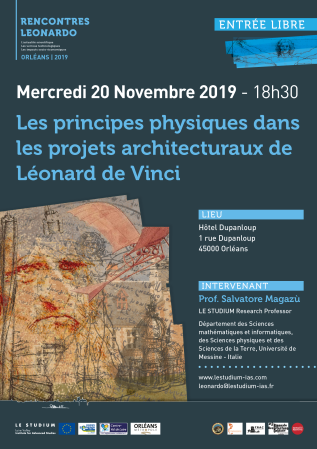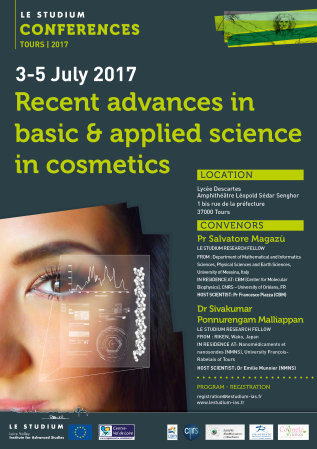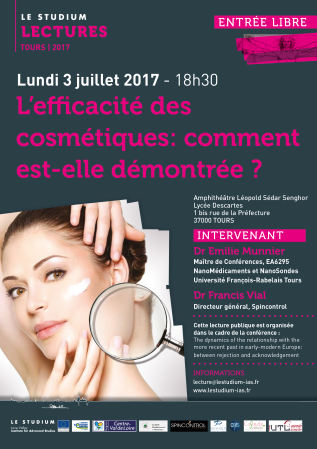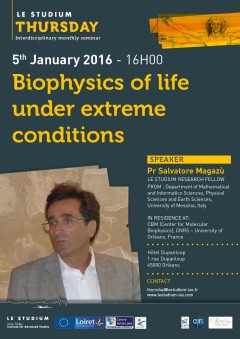Prof. Salvatore Magazù

Établissement d'origine
Laboratoire hôte
Centre de Biophysique Moléculaire (CBM) / CNRS - FR
Hôte scientifique
Prof. Francesco Piazza
PROJET
The proposed project is focused on the use of a class of sugars, i.e. trehalose and its homologues, and polyols, e.g. glycerol, in innovative cosmetic formulations and technologies, based on a detailed knowledge of the molecular mechanisms responsible for their stabilizing and hydrating functions. Moreover, our project will deliver a nanoscopic characterization of confinement and crowding effects on such natural active ingredients as encapsulated in proper delivering systems and embedded in realistic media. Such natural molecules have received in the last years a growing attention both from the scientific and applicative points of view. The interest is due not only to their effectiveness as bio-protecting systems conferring to biomolecules a higher stability and resistance under stress conditions, but also to their nature of glass-forming systems characterized by phases of different specific density and entropy but identical composition (polyamorphism). The remarkable properties of trehalose have interesting implications in cosmetic research. At low concentration values, such as those used in lotions, the protective action of trehalose is mediated by water, which reduces the solvent power, while at high concentration values, such as those used in creams, sugar induces an increment of the hydration radius and geometric changes of the micelles due to interaction between trehalose molecules and micelles. It clearly emerges that the available experimental findings are consistent with the existence of a direct connection between the melt fragility degree of the ensuing glassy matrix and bioprotective effectiveness. In the cosmetic field, sugars as trehalose can be used as humectants, moisturizers and flavoring agents in creams, lotions and masks; on the other hand, polyols as glycerol can be employed as cosmetic bonding agents for makeup, including eye shadow, lipgloss, lotions and eyedrops; moreover, many protein derivatives are currently used for cosmetic purposes. These are typically obtained from simple proteins (fibrous and globular). In particular, the simple and widely studied structure of lysozyme makes this protein particularly interesting for more complex investigations in the field of cosmetics. The innovation in formulation, conception of cellular tools and technologies will be achieved by following main research lines:
- to characterize the thermal behavior of binary mixtures of trehalose and glycerol and ternary mixtures of lysozyme, trehalose and glycerol by the determination of their phase diagrams;
- to determine the mobility in the binary mixtures of trehalose and glycerol and ternary mixtures of lysozyme, trehalose and glycerol at the single-particle level;
- to identify proper nanosystems specifically designed for delivering these natural active ingredients (trehalose, glycerol, …) through the stratum corneum;
- to determine the confinement effect and the role of relevant thermal changes on the structure, dynamics and function as well as on the stability of the encapsulated natural active ingredients;
- to evaluate the effect of macromolecular crowding effect on the enzyme kinetics even during the catalytic action in the encapsulated ternary systems;
- to characterize the aggregation/auto-organization mechanisms which are activated by changing both the nanosystem and the combination of confinement level and hydration conditions.
The knowledge transfer to industries will be based not only on a joint research programme but also on an educational-training programme encompassing a series of short meetings, seminars, specific experimental stages at the hosting laboratories, two-days conferences focused on remarkable aspects answering to specific industrial needs.
Publications
Background: The use of electromagnetic fields has been considered as adjuvant therapy for the treatment of cancer given that some clinical trials have shown that the irradiation of cancer cells with electromagnetic fields can slow down the disease progression.
Aims: We hypothesize that this effect could be amplified by irradiating tumor cells with electromagnetic fields having frequencies close to the natural resonant frequencies of membrane channels in tumor cells, in order to obtain a significant change of the ion flux across tumor cell membrane channels, inducing the largest harmful alteration in their cellular function.
Methods: Neuronal-like cells were used as a cell model and exposed for 6 h to electromagnetic fields at different frequencies (0, 50 Hz, 900 MHz) at the same intensity of 2 mT. The exposure system was represented by two Helmholtz coils driven by a power amplifier in current mode and an arbitrary function generator. FTIR spectroscopy was used to evaluate the results of the exposure.
Results: The results of this study showed that the Amide I vibration band increased in intensity with the increase of the frequency, leading us to assume that the displacement of the cell channels α-helices depends on the frequency of the applied electromagnetic fields.
Conclusion: This preliminary result leads us to plan future research aimed at searching for the natural frequencies of membrane channels in tumor cells using resonant electromagnetic fields in
To dynamically characterize the thermal properties of the fructose-rich exopolysaccharide (EPS1-T14), produced by the marine thermophilic Bacillus licheniformis T14, the Attenuated Total Reflectance Fourier Transform Infra-Red spectroscopy was coupled to variable temperature ranging from ambient to 80 °C.
The spectra were analyzed by the following innovative mathematical tools: i) non-ideal spectral deviation, ii) OH-stretching band frequency center shift, iii) spectral distance, and iv) wavelet cross-correlation analysis.
The thermal restraint analysis revealed that the whole EPS1-T14 system possessed high stability until 80 °C, and suggested that fucose was mainly involved in the EPS1-T14 thermal stability, whereas glucose was responsible for its molecular flexibility.
Our results provide novel insights into the thermal stability properties of the whole EPS1-T14 and into the role of its main monosaccharidic units. As a new biopolymer, the thermostable EPS1-T14 could be used in traditional biotechnology fields and in new biomedical areas, as nanocarriers, requiring high temperature processes.
Background:
Previous studies have shown that exposure to high frequency electromagnetic fields induces alterations in simple organic systems such as proteins in bidistilled water solution.
Objective:
The aim of this study was to test the shielding action of sodium chloride in bidistilled water solution against exposure to a high frequency electromagnetic field, in order to evaluate if the addition of NaCl in proteins aqueous solution can be considered a valuable bioprotector against electromagnetic fields.
Method:
Samples of 250 μl of different hemoglobin aqueous solutions, in the absence or presence of sodium-chloride, were exposed for 3 hours to an electromagnetic field at 1750 MHz at a power density around 1 W/m2 emitted by an operational mobile phone. Fourier Transform Infrared Spectroscopy was used to study the effects of exposure on the secondary structure of hemoglobin also in the presence of sodium-chloride.
Results:
Spectral analysis evidenced that significant increase in intensity of the Amide I and II vibration bands in hemoglobin bidistilled water solution occurred after exposure to the electromagnetic field. This result can be due to the increase of dipole moment of the protein due to the alignment of α-helix towards the direction of the field. In contrast, no appreciable change was observed in hemoglobin in sodium-chloride water solution after exposure.
Conclusion:
This protective effect of sodium-chloride can be explained by the orientation of water molecules due to the strong electric field around each ion that reduces the possibility of rotation of the protein in response to an applied electromagnetic field.
Background: This paper would be a starting point addressed to a methodology to minimize the effects on livings of man made Electromagnetic Fields (EMFs) pollution. Methods: Given that previous literature highlighted that the most relevant EMFs effects on biological systems can be due to resonance phenomena between electromagnetic field and organic matter, it was proposed here an algorithm to obtain values of frequencies of an applied electromagnetic field far from resonant frequencies, depending on the natural frequencies and viscous damper of a biological system. These frequencies have been named non-resonant frequencies. Results: The displacement of the α-helices in cellular membrane channels due to EMFs has been proposed as a relevant parameter for quantifying the result of the interaction between an applied EMF and organic matter, in order to find both the natural frequencies of a biological system and the resonant frequencies at which α-helices displacement should be maximum. Conclusion: The non-resonant frequencies can be obtained using the algorithm proposed here.




